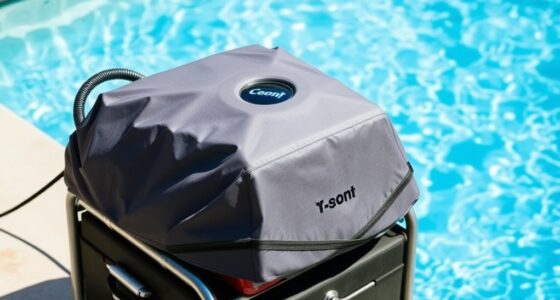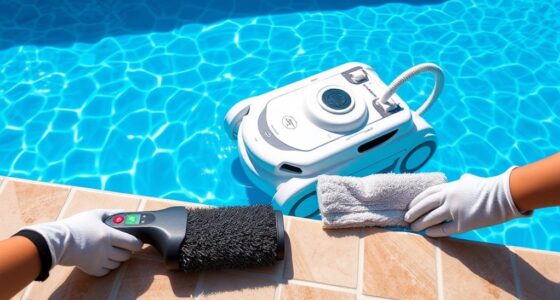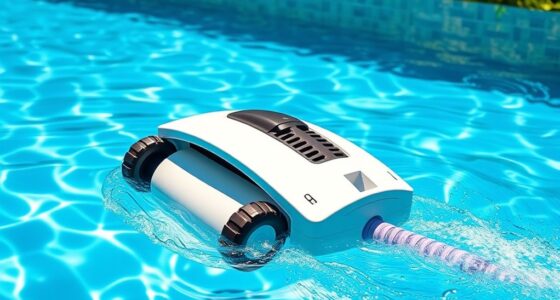Automatic pool cleaners are great for removing debris, but they can’t handle algae or cloudy water on their own. They don’t control chemical balance, sanitize, or scrub algae from surfaces, so you’ll still need to manually treat the water with chemicals and scrub the walls. Some cleaners have special brushes or filters to help, but addressing algae and cloudiness requires a combined approach. Keep going, and you’ll discover the best ways to keep your pool crystal clear.
Key Takeaways
- Automatic pool cleaners excel at removing debris but do not control algae growth or water chemistry.
- They help improve clarity by removing loose algae and particles but cannot eliminate persistent algae on surfaces.
- Proper chemical balancing and manual brushing are essential, as cleaners alone cannot fully address algae or cloudiness.
- Advanced robotic cleaners with specialized brushes and filters can assist in algae control when combined with chemical treatments.
- Regular filter maintenance and water chemistry checks are crucial for maximizing cleaner effectiveness and maintaining clear, algae-free water.
How Automatic Pool Cleaners Work and Their Limitations
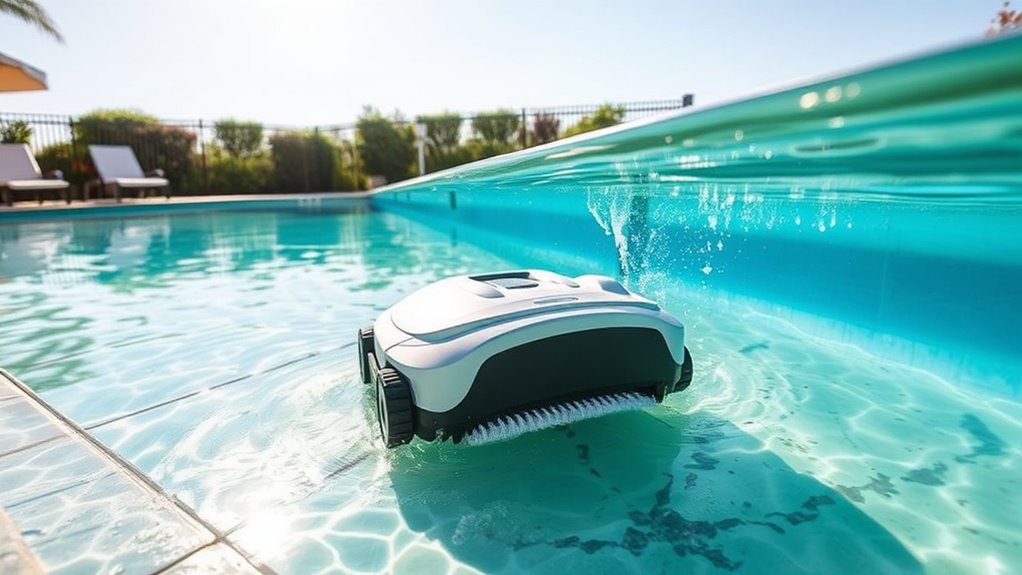
Automatic pool cleaners operate by moving across the pool surface and floor, using programmed pathways or random patterns to collect debris. They excel at removing leaves, dirt, and larger particles but don’t address chemical reactions that affect water clarity. Since they don’t control chemical levels, algae and bacteria can still thrive if you neglect proper chemical balance, necessitating manual cleaning and chemical adjustments. These cleaners don’t replace the need for regular chemical treatment or skimming, especially when dealing with algae buildup. Their primary role is physical debris removal, so if your pool has cloudy water or algae, you’ll still need to manually brush, vacuum, and manage chemical reactions to achieve clear, healthy water. Automatic cleaners are a helpful tool but aren’t a complete solution on their own.
Effectiveness Against Algae Buildup
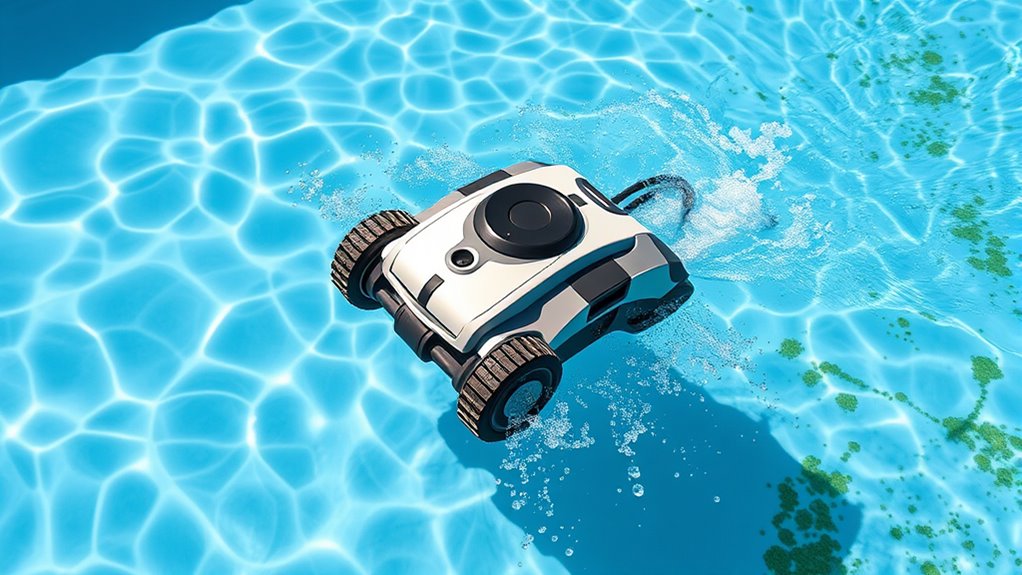
While automatic pool cleaners are effective at removing surface debris, their ability to combat algae buildup is limited. Algae thrive in unbalanced water, so proper chemical balancing is essential before relying on your cleaner. These devices don’t typically target algae clinging to walls or the pool floor, so manual scrubbing becomes necessary to break up stubborn growth. Automatics can help remove loose algae on surfaces, but they won’t replace thorough cleaning. Regular brushing combined with chemical treatments is your best defense against algae proliferation. Additionally, understanding water chemistry is crucial for maintaining a healthy pool environment. It’s also important to monitor water pH levels regularly, as imbalances can promote algae growth. Relying solely on your cleaner won’t keep algae at bay; instead, integrate manual scrubbing and proper chemical balancing to ensure your pool remains clear and algae-free. Maintaining proper sanitation practices is also key to preventing algae growth over time, especially as algae spores can be introduced through environmental factors.
Handling Cloudy Water With Robotic Cleaners

Cloudy water can be a sign that your pool needs a thorough cleaning, and robotic cleaners are effective tools for tackling this issue. They help remove debris and algae that cloud the water, but proper pool chemistry is essential for clear water. Ensuring the correct pH, alkalinity, and sanitizer levels prevents algae growth and clarifies the water. Robotic cleaners work best when combined with regular filter maintenance, as a clean filter captures fine particles that cause cloudiness. Check and clean your filter frequently to maintain ideal flow and filtration. Using a robotic cleaner alongside balanced pool chemistry and consistent filter upkeep keeps your water sparkling and inviting, reducing the need for chemical shock treatments and making pool maintenance more manageable. Additionally, adopting a structured routine for pool care can help maintain water clarity and prevent recurring cloudiness. Regular filter replacement, typically every 6-12 months, is crucial for sustained effectiveness for allergen removal, ensuring your cleaner operates at peak performance. Maintaining proper chemical balance is also vital for preventing algae growth and ensuring water clarity. Incorporating tools with advanced filtration technology can further improve the removal of fine particles and contaminants.
Types of Pool Cleaners and Their Algae-Fighting Capabilities

Choosing the right pool cleaner can make a significant difference in fighting algae and maintaining clear water. Different types of cleaners offer varying algae-fighting capabilities, essential for effective pool maintenance and algae prevention. Robotic Cleaners – These are excellent for thorough cleaning and can target algae buildup with specialized brushes and filters. Suction-Side Cleaners – They connect to your skimmer and use suction power to remove debris, helping reduce algae spores in the water. Pressure-Side Cleaners – Powered by water pressure, these cleaners are good for larger pools and can help prevent algae by keeping surfaces clean and debris-free. Additionally, selecting a cleaner with effective algae control features can enhance overall pool sanitation and reduce the frequency of chemical treatments. Regular maintenance of your pool filtration system is also crucial in preventing algae growth and ensuring the cleaner’s optimal performance. Incorporating proper chemical balance into your routine further minimizes algae development and supports the efficiency of your cleaning equipment. Proper water circulation is also vital, as stagnant water promotes algae growth and reduces cleaning effectiveness. Using a cleaner with advanced filtering technology can help trap smaller particles, including algae spores, more effectively.
Tips to Maximize Cleaner Performance for Problematic Pools

To get the most out of your pool cleaner in problematic pools, you need to optimize its performance through proper maintenance and strategic use. First, ensure your pool’s chemical balance is correct; imbalanced water can hinder cleaning and promote algae growth. Regularly test and adjust pH, chlorine, and alkalinity levels to keep the water clear. Additionally, manual brushing of the pool’s surfaces before running the cleaner helps loosen stubborn algae and debris, making the cleaner’s job easier. Clear surfaces reduce strain on the device and improve coverage. Keep the filter clean and replace it if necessary to maintain suction and filtration efficiency. These steps help your automatic cleaner perform at its best, even in challenging conditions, ensuring a cleaner, healthier pool. Also, be mindful of signs of spoilage in any cleaning supplies or pool chemicals to prevent introducing contaminants that could worsen algae problems. Proper storage and handling of chemicals can prevent contamination that might compromise the water quality. Regularly inspecting and maintaining your equipment can prevent malfunctions that reduce cleaning effectiveness and prolong device lifespan. Furthermore, considering filter replacement indicators can help ensure your cleaner consistently operates at peak performance. Additionally, referencing manufacturer-specific deep cleaning techniques can help maintain optimal functioning for your particular model.
When to Use Additional Treatments for Algae and Cloudiness

If algae or cloudiness persist after regular cleaning, it’s time to contemplate additional treatments. You’ll want to recognize when algae is stubborn or cloudiness is severe enough to require extra steps. Knowing when to act can help you keep your pool crystal clear and safe to use. Incorporating sound healing science techniques, such as calming vibrations, can also complement traditional cleaning methods to promote overall pool health. Understanding vulnerability assessment principles can ensure that your pool’s systems are properly evaluated for potential issues that might contribute to algae growth or cloudiness. Regular chemical balance checks are also crucial in preventing recurring problems and maintaining water clarity.
Recognizing Persistent Algae
Persistent algae can be tricky to eliminate, especially when your automatic pool cleaner struggles to fully clear the water. Recognizing when algae is truly persistent involves careful algae detection and monitoring your pool chemistry. If algae keeps returning despite regular cleaning, it’s a sign you need additional treatment.
Consider these indicators:
- The water remains green or cloudy even after cleaning.
- Algae patches reappear quickly, showing it’s not fully eradicated.
- Pool chemistry is out of balance, with low sanitizer levels or improper pH.
When these signs appear, it’s time to boost your approach with extra chemicals and proper chemical balancing. This ensures algae doesn’t hide in unseen spots and prevents future growth.
Addressing Severe Cloudiness
Severe cloudiness often signals that your pool needs more than routine cleaning, especially when algae particles and organic debris have accumulated beyond what your automatic cleaner can handle. In such cases, chemical treatments are essential to break down contaminants. Manual brushing of pool walls and floor helps dislodge stubborn algae and debris, allowing chemicals to work more effectively. Recognize when to escalate your efforts with this table:
| Situation | Recommended Action |
|---|---|
| Persistent cloudiness after cleaning | Use algaecides and clarifiers |
| Visible algae or organic buildup | Manual brushing plus chemical shock |
| Cloudiness with algae presence | Chemical treatments + manual brushing |
| No improvement after treatments | Consult a professional or consider draining |
Addressing severe cloudiness quickly prevents long-term damage and restores clarity.
Frequently Asked Questions
Can Robotic Pool Cleaners Remove Algae From Pool Surfaces Effectively?
Robotic pool cleaners can effectively remove algae from pool surfaces when combined with proper water filtration and pool safety practices. While they excel at scrubbing and vacuuming visible algae, you should also maintain good water circulation and filtration to prevent algae buildup. Regularly checking chemical levels and ensuring the cleaner covers all areas helps keep your pool clean and safe, reducing the risk of algae spreading and maintaining overall water quality.
How Do Automatic Cleaners Handle Stubborn Algae Patches?
Imagine your pool as a mirror, suddenly clouded by stubborn algae patches. Automatic cleaners can target surface debris but struggle with persistent algae. To handle these patches, you need to guarantee your pool’s chemical balance is correct, and manual brushing is essential to loosen stubborn growth. Then, let the cleaner do its job. Combining chemical treatment, manual brushing, and automatic cleaning gives you the best shot at a crystal-clear pool.
Are Robotic Cleaners Suitable for Large or Commercial Pools With Algae?
For large or commercial pools with algae, robotic cleaners can be effective, but their suitability depends on durability and cleaning power. You need a robotic cleaner designed for commercial pool maintenance, which offers higher durability to withstand frequent use. While they can handle algae and large debris, you might also need to supplement with chemical treatments to guarantee thorough sanitation. Always choose a model built for heavy-duty, commercial environments.
Can Robotic Cleaners Replace Chemical Treatments for Algae Control?
Imagine your pool as a garden that needs both watering and weeding. While robotic cleaners are like diligent gardeners, they can’t replace chemical treatments entirely. Chemical alternatives like algaecides and proper filtration work as your garden’s fertilizer, preventing algae from sprouting. So, you can’t solely rely on robotic cleaners for algae prevention; combine them with chemical treatments to keep your pool sparkling and algae-free.
How Often Should I Run My Automatic Cleaner During Algae Outbreaks?
During algae outbreaks, you should run your automatic cleaner daily to maintain cleaning frequency and guard against algae buildup. Regular cleaning helps break down algae and keeps the pool water clear. Combine this with proper chemical treatments for algae prevention. Running your cleaner consistently ensures debris removal and reduces the chances of algae thriving, making your pool safer and more inviting. Adjust the schedule based on the severity of the outbreak for best results.
Conclusion
While automatic pool cleaners are like loyal helpers, they can’t conquer algae or cloudy water alone. Think of them as your pool’s first line of defense, sweeping away debris but needing your help to fight stubborn algae and haze. To keep your pool crystal clear, combine their cleaning power with proper chemical treatments. Together, you’ll create a sparkling oasis, turning your pool from a murky pond back into a inviting paradise.



